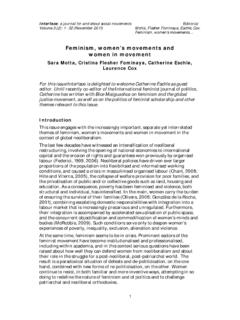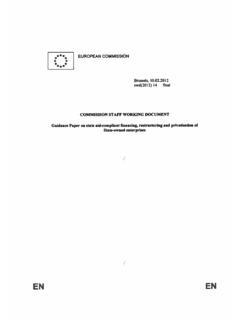Transcription of MALAYSIA - ANNEX 4 1. Introduction 2. Background
1 Agenda Item Eco Reform-Att A-Ann 4 MALAYSIA - ANNEX 4 1 EWG20 A-Ann 4 1. Introduction This ANNEX sets out our findings in relation to the current status of implementation of the IPP Principles in MALAYSIA . In relation to each Principle the current status of implementation is described. Where possible and appropriate, we have identified potential barriers or impediments to improved implementation of the Principles. These findings reflect research carried out in the period January April 2000. 2. Background Recent developments in the Malaysian electricity sector Electricity generation in MALAYSIA is dominated by three utilities: Tenaga Nasional Berhad ( TNB ) in Peninsula MALAYSIA ; Sabah Electricity Sdn Bhd ( SESB ) in the State of Sabah; and Sarawak Electricity Supply Corporation ( SESCO ) in the State of Sarawak.
2 These utilities operate independently of one another in their separate jurisdictions. The grids in these three jurisdictions are currently not interconnected. TNB, a publicly listed company, has a monopoly over the transmission and distribution of electricity in Peninsular MALAYSIA . TNB is responsible for electricity generation, transmission and distribution and retail supply in Peninsula MALAYSIA . TNB was formed in 1990, following the corporatisation of the National Electricity Board in line with the implementation of the Government s privatisation policy. Since 1996, TNB has been undergoing substantial internal restructuring with the formation of many subsidiary companies.
3 Presently, TNB Generation Sdn. Bhd. (a wholly owned subsidiary TNB) is entrusted with the function of the generation business and the transmission and distribution section taken over by TNB Transmission Sdn. Bhd. and TNB Distribution Sdn. Bhd. respectively. The other main electricity entities, SESB and SESCO, are involved in the generation, transmission and distribution activities in the East of MALAYSIA . SESB, formerly known as Lembaga Letrik Sabah, was privatised on 1 September 1998 and aims to ensure the reliability and security of the electricity supply system to consumers in Sabah and Labuan. SESCO is a State Statutory Body incorporated under the Sarawak Electricity Supply Corporation Ordinance, 1962 and is responsible for the generation, transmission and distribution of electricity in Sarawak.
4 On 31 January 1996, Sarawak Enterprise Corporation Bhd. (formerly known as Dunlop Estate Bhd.), a public listed company, bought over 45% stake of the Corporation from Sarawak State Agenda Item Eco Reform-Att A-Ann 4 EWG20 Att A-Ann 4 2 Government. It will remain in its current status to cater for the generation, transmission, distribution and use of energy in the two This report deals almost exclusively with TNB, as there is a lack of information in respect of SESB and SESCO. It covers only TNB except where SESB and SESCO are specifically mentioned, as not all the facts and assumptions about reforms referred to in this report apply to SESB and SESCO.
5 MALAYSIA currently has approximately 11,800 MW of electric generation capacity and in 1997 it generated around billion kWh of electricity. Despite MALAYSIA s economic downturn, projections indicate that MALAYSIA s demand for electricity is expected to continue to grow. For example, peak demand for electricity is expected to grow from 8,471 MW in 1998 to 14,095 MW in 20072. It is expected that the country s energy reserve margin will drop below the psychological barrier of 30% by 2001. The role of IPPs in MALAYSIA To keep pace with the goal of making MALAYSIA a developed nation by the year 2020 and meet the expected national demand for electricity, the Government has turned to the private sector to supplement the supply of the required generating capacity with the Introduction of IPPs.
6 Since an initial IPP round was held in 1992, a total of 155 IPP licences had been granted up until October Since 1993, 15 IPPs, including one mini-utility have been granted have licenses of which 11 are in Peninsular MALAYSIA and 4 in Sabah. In addition, there are also a number of licensed co-generators operating throughout MALAYSIA in specific areas. During the 7th MALAYSIA Plan period (1996-2000), the country planned to commission more than 4,000 MW of electricity generation capacity, to bring the total to around 15,000 MW by However, the recent economic problems have caused delays for some of the projects. Most notable is the US$ GW Bakun hydroelectric project in Sarawak where the project rights have been relinquished to the government.
7 There are presently five IPPs in Peninsula MALAYSIA . These are: Powertek Sdn. Bhd; Port Dixon Sdn. Bhd.; Genting Sanyen (Power) Sdn. Bhd.; 1 Asia Pacific Research Centre, Electricity Sector Deregulation in the Asia Pacific Region, Tokyo, 1999, p 122. 2 Id. p 25. 3 Bank of America et. al. Operationalisation of Independent Grids System Operator , A Proposal for the Economic Planning Unit, October 1998, p 21. 4 Energy Information Administration, MALAYSIA , EIA, May 1999, p 5. Agenda Item Eco Reform-Att A-Ann 4 EWG20 Att A-Ann 4 3 Segari Energy Ventures Sdn. Bhd.; and YTL Power Generation. There are three further IPPs under construction in MALAYSIA .
8 Further, the IPPs in Sabah comprises: ARL Tenaga Sdn. Bhd.; Serudong Power Sdn. Bhd.; Powertron Resources Sdn. Bhd.; Stratavest Sdn. Bhd.; and Sandakan Power Corporation Sdn. Bhd. As a result of the pressure for extra capacity in the early 90 s, IPPs were introduced into MALAYSIA in 1994. IPPs were to complement the national utility (TNB) in providing for the extra demand for electricity. Presently, under the Power Purchase Agreements (PPA), IPPs are only allowed to sell electricity to TNB or SESB, as the case may be. There is some indication that the process for obtaining approvals for new independent power projects may be lacking in transparency to some extent.
9 This appears to be the most significant difficulty facing new IPP projects in MALAYSIA . In light of the recent financial crisis, there may be difficulties in securing the necessary finance required by IPPs to undertake the projects. 3. Institutional and Regulatory Structures Principle 1: Energy sector policies Energy sector policies formulated to create a stable framework for power sector development (a) Clear, published and consistent energy sector policies The principles addressed by the National Economic Recovery Plan (NERP) Privatisation Master Plan 1991 and Ministry of Energy Policies provide the broad policies guiding the energy sector. In the case of the Privatisation Master Plan 1991 a change of the Registry Act 1949 was proposed where TNB was identified as a flagship candidate.
10 One of the 7th MALAYSIA Plan s objectives is to establish an IGSO. Under the NERP, which was introduced in July 1998, foreign ownership in insurance companies was allowed to increase from 49% to 51%. However, this lift in restriction has not flowed to the energy sector. These are in line with the policies guiding the privatisation and corporatisation of the electricity sector. The enshrined objective of the Ministry of Energy, Communications and Multimedia s policies is to ascertain and ensure development, supply and service in the industries involved at the required levels in Agenda Item Eco Reform-Att A-Ann 4 EWG20 Att A-Ann 4 4 line with the country's interest as well as to regulate and update the quality of energy, communications and multimedia services to ensure that they are effected according to fixed standards.




